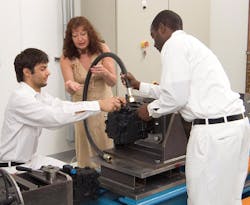Researchers at Purdue University, West Lafayette, Ind., have shown how to dramatically improve the efficiency of hydraulic pumps and motors in heavy construction equipment, thereby reducing fuel consumption of mobile equipment. Their new designs eliminate valves otherwise needed to direct the flow of hydraulic fluid in heavy equipment and may incorporate textured “microstructured” surfaces inside pumps to improve performance.
Research has shown the “valveless” design alone could reduce fuel consumption by 40%. Further savings could be realized by combining the valveless design with the advanced microstructured surface concept, said Monika Ivantysynova, PhD, Maha Fluid Power Systems Professor at Purdue’s School of Mechanical Engineering.
The microstructured surfaces have been shown to dramatically reduce power losses due to friction caused by hydraulic fluid, said Ivantysynova. Findings were detailed in several technical papers presented by her research group earlier this summer at the Fifth Fluid Power Net International Ph.D. Symposium in Krakow, Poland.
Efficiency at under varying load
“Currently, the best pumps and motors may have a top efficiency of 92%, but this occurs only within a certain range of operation,” Ivantysynova explained. “These hydraulic pumps don’t always run at this maximum level. Sometimes you only need them to provide a small amount of pressure or flow, for example, to simply hold a tool in place. Then you aren’t running the pump under its highest loads, and the efficiency goes way down.”
Findings have shown the microstructured surfaces reduce losses due to friction as much as 57% when the pump operates at low output and about 10% when heavily loaded. One of the research papers about the microstructured surfaces was cited as a “best paper” during the conference and was written by graduate student Jonathan Baker and Ivantysynova.
Engineers in the center are working on ways to design pumps and motors that are more efficient in their entire range of operation.
Conventional hydraulic systems use a central pump that delivers fluid to actuators through valves. The new valveless design provides each actuator with its own pump, eliminating the need for valves. An excavator has been equipped with the new valveless technology in the Purdue center.
Microstructured surfaces
The microstructured surfaces occur in narrow gaps at several locations inside a pump, and the gaps contain hydraulic fluid. The fluid-filled gaps, which seal the high-pressure chamber and serve as bearing surfaces, are a major source of power losses.
“We are working on those gaps by using computer simulations to understand all the physical effects and to reduce efficiency losses due to friction caused by the viscosi ty of hydr aul i c fluid,” Ivantysynova contined. “We know our simulations are very close to the real physics, and we are currently working to manufacture the surfaces and chamwill do measurements.”
Conventional wisdom states that the surfaces should be polished smooth, but Ivantysynova discovered that having a surface containing features 1-μm high improves efficiency. The gaps are located between the pump’s piston and cylinder walls and between the cylinder block and valve plate.
Ivantysynova made the microstructured surface discovery while studying the effects of improperly machined surfaces. “We learned that it actually improved performance to have surfaces that were not completely smooth, which was unexpected,” she said.
Engineers in the center are building a test rig of the hydraulic hybrid design, and Purdue has filed a patent on the concept, called an advanced gap surface design.
For more information, contact Monika Ivantysynova, Ph D. at (765) 496-6578, or e-mail [email protected].


